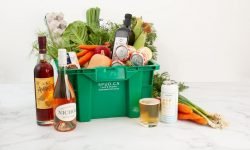The world has changed in the past year faster than it has in a long time,…
For the majority of Canadians, it is hard to imagine going a day without the use of plastic. Whether it be single-use, compostable, or reusable, we all have become extremely dependent on plastic in a very short amount of time. However, in the last few years, as the failures of recycling and the consequences of plastic pollution become known, voices of doubt and dismay for our plastic dependency are growing louder and more urgent.
How often do you look down at your recycling bin full of food packaging balanced in a heaping pile like Jenga, and think “how did we get here?” This week, we are hoping to answer this question.
The beginning
First, let’s define what we are talking about. Plastic is a material “produced from building block molecules (monomers) which are then chemically linked to form chains (polymers)” (1). The vast majority of these monomers are made from crude oil or natural gas (2).
The first plastic was invented back in 1907 by a chemist named Leo Baekeland (3). Years later, as our economy quickly transformed from a primarily local network to a global web exchanging goods and services, our market became increasingly reliant on packaging as a way to protect goods being moved across far distances (4).
The rise of plastic
From 1960 to 2013, the use of plastic increased 84 times as it became preferable over glass, metal, and other types of packaging (5). Plastic was favoured because it was cheaper, lighter, and could store products extremely well in comparison to its counterparts. It was also introduced where packaging was previously not used, such as shrink wrap for cucumbers, since it was able to extend the product’s shelf-life for up to 15 days (6). As food began to travel farther distances from farm to fork, plastic packaging became vital to reduce food waste along the supply chain.
Where we are today
In Canada, 3.84 million tonnes of plastics are generated yearly, with only about 12% being recycled (7). Globally, only about 2% of plastics are recycled to replace the creation of new plastic, while 95% of plastics are “lost to the global economy after only a single-use” (8).
This is why we are finding plastic in literally everything and why people are starting to reject it.
However, to play devil’s advocate, some research calculates that if plastics were to be replaced with other materials, there would be an overall increase in municipal solid waste by 58% (9). Additionally, a different study found that if plastics were replaced by other materials, the environmental costs would rise from $130 billion to $533 billion due to the resources and energy demands of other materials (10).
With this in mind, it’s worth questioning whether we have perhaps misidentified plastic as the main cause of the waste crisis, and if this reality would have happened even without the creation of plastic.
The future
The real cause of our waste crisis is that we have allowed for the existence of waste. That may sound confusing, but stick with me!
The way we treat packaging right now is following a “take-make-dispose” model where packaging is not designed to be recycled efficiently or reused. We need to transition to a “circular” model, where packaging is designed to be repurposed. To create a circular economy, a lot needs to change. Here are a few of the major ones:
1. Manufacturers should be required to use already recycled material rather than using exclusively “virgin” material when creating packaging. This will create demand for recycled content that currently does not have a strong market. One of our vendors, Preserve, is leading the way on this initiative!
2. Packaging that is sold in a certain region needs to be compatible with what the local recycling programs are able to recycle. Right now, a lot of “recyclable” packaging is being sold in areas where it cannot be recycled at home causing a lot of consumer confusion and waste. Have you heard of Spud’s takeback program? With this initiative, we are taking full responsibility for our packaging.
3. As consumers, we need to refuse packaging wherever possible. Adopting reusable alternatives can help you avoid single-use packaging very easily!
Sources:
- Report: A vision for a circular economy for plastics in Canada: The benefits of plastics without the waste and how we get it right. Smart Prosperity Institute. February 2019.
- Ibid.
- Davis, Heather. “Life & death in the Anthropocene: A short history of plastic.” Art in the anthropocene: Encounters among aesthetics, politics, environments and epistemologies (2015): 347-358.
- Ibid.
- Role of plastics in decoupling municipal solid waste and economic growth in the U.S. Author links open overlay panelDemetra A.TsiamisMelissaTorresMarco J.Castaldi Earth Engineering Center, Department of Chemical Engineering, City College of New York, CUNY, New York, NY 10031, United States.Received 18 November 2017, Revised 11 April 2018, Accepted 2 May 2018, Available online 26 May 2018.
- Institute for European Environmental Policy. Plastic Packaging and Food Waste – new perspectives on a dual sustainability crisis. Last Revised: April 10 2018. https://ieep.eu/publications/plastic-packaging-and-food-waste-new-perspectives-on-a-dual-sustainability-crisis
- Report: A vision for a circular economy for plastics in Canada: The benefits of plastics without the waste and how we get it right. Smart Prosperity Institute. February 2019..
- The New Plastics Economy: Rethinking the future of plastics. Ellen MacArthur Foundation. Strategy on Zero Plastic Waste. Canadian Council of Ministers of the Environment. November 23, 2018.
- Role of plastics in decoupling municipal solid waste and economic growth in the U.S. Author links open overlay panelDemetra A.TsiamisMelissaTorresMarco J.Castaldi. Earth Engineering Center, Department of Chemical Engineering, City College of New York, CUNY, New York, NY 10031, United States. Received 18 November 2017, Revised 11 April 2018, Accepted 2 May 2018, Available online 26 May 2018.
- Lord, R. “Plastics and sustainability: A valuation of environmental benefits, costs and opportunities for continuous improvement.” (2016).




